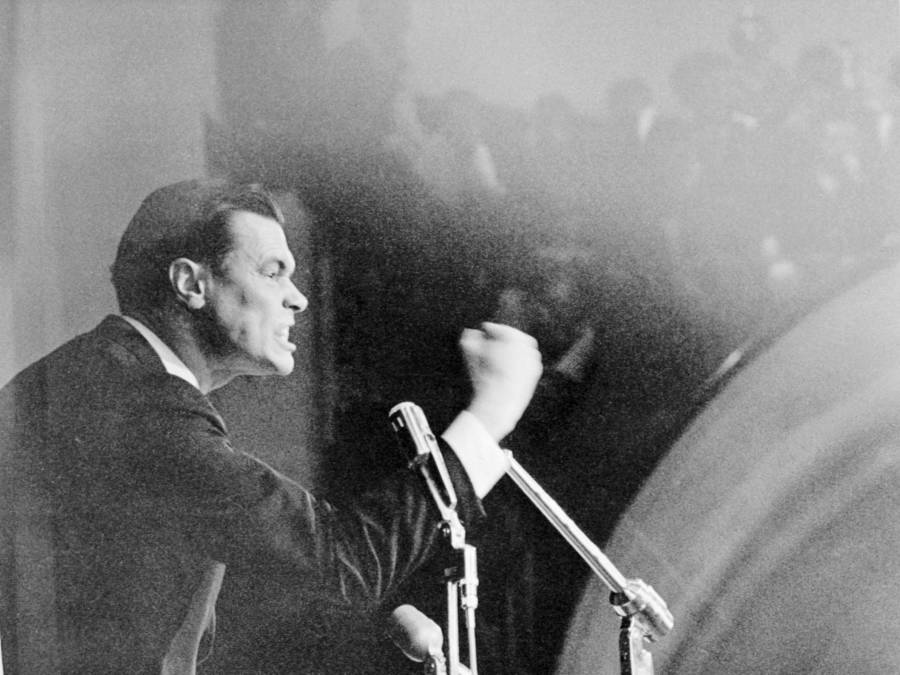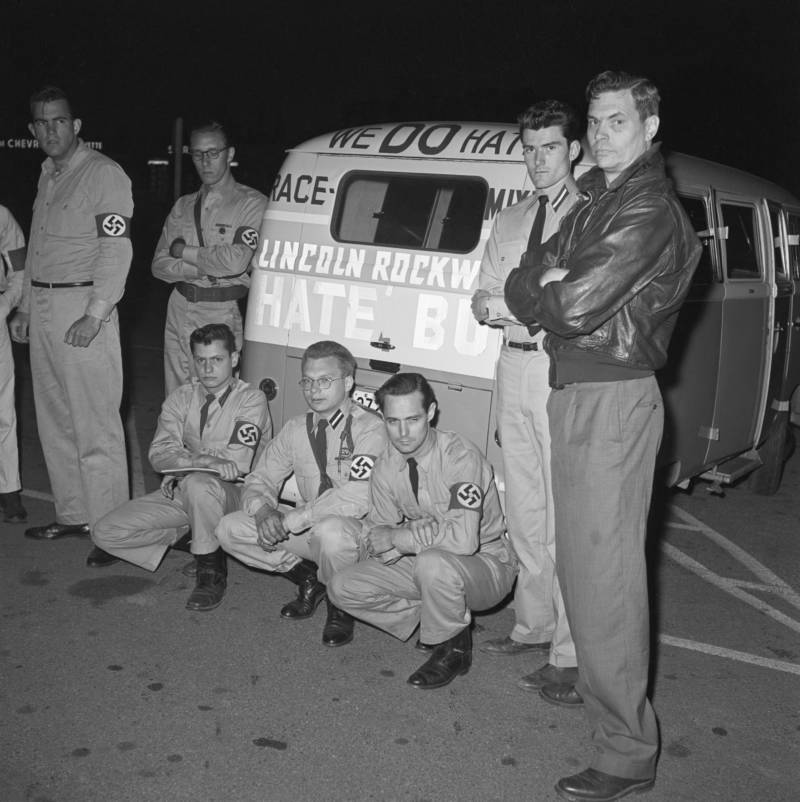The story of George Lincoln Rockwell, the man whose legacy of hate lives on to this day.

Bettmann / Contributor via Getty ImagesGeorge Lincoln Rockwell, leader of the American Nazi Party, shakes his fist during his speech at Drake University on February 13, 1967.
When future American Nazi Party founder George Lincoln Rockwell first heard that Senator Joseph McCarthy was embarking upon a witch hunt to ferret out suspected communism and homosexuality in the U.S. government during the 1950s “Red Scare,” he reacted differently than most.
“I began to pay attention, in my spare time, to what it was all about,” Rockwell later wrote in his 1961 book, This Time the World. “I read McCarthy speeches and pamphlets and found them factual, instead of the wild nonsense which the papers charged was his stock-in-trade. I became aware of a terrific slant in all the papers against Joe McCarthy, although I still couldn’t imagine why.”
McCarthy wasn’t the only 20th century demagogue under whose spell Rockwell would fall.
George Lincoln Rockwell’s Early Life
Little in George Lincoln Rockwell’s upbringing suggested that he’d fall for the teachings of Adolf Hitler and ultimately go on to found the American Nazi Party. His parents both worked as old-time vaudeville comics, and his father’s show business acquaintances included Fred Allen, Benny Goodman, Walter Winchell, Jack Benny and even Groucho Marx.
When Rockwell was six, however, his parents divorced and Rockwell split his time between his mother’s home in Atlantic City, New Jersey, and Boothbay Harbor, Maine, where his father lived.
In 1938, Rockwell made it into Brown University, where he began honing the viewpoints that would later inform those of the American Nazi Party. There he also met his first wife, debated his fellow sociology students about how people are not born equal, and drew cartoons for the campus humor magazine, dropping out less than two years later and joining the Navy.
He completed his pilot training in time to serve in World War II. Rockwell never flew in combat, but by the time the war ended, the Navy gave him command over an attack squadron at Pearl Harbor.
After the war ended, he tried his hand at many different careers — from studying art at the Pratt Institute in Brooklyn and winning a prestigious award to working as a freelance photographer — but nothing ever seemed to pan out.
“An All-Out Nazi”

Underwood Archives/Getty ImagesGeorge Lincoln Rockwell leads a group of his supporters, 1967.
In 1950, when Rockwell was 32 years old, the Navy recalled him to active duty to serve in the Korean War. While he stayed at the naval base in San Diego for the entirety of the war, he did manage to meet a certain couple who gave him an anti-Semitic pamphlet.
Rockwell actually first dismissed it as racist, but some fascination kept his interest until he read it cover-to-cover and back again.
This proved to be life-changing for Rockwell, and he soon began devouring anti-Semitic hate literature. When he found a copy of Mein Kampf in an old bookstore, the antisemitism and white nationalism that had taken root in his mind began to flourish.
“I was hypnotized, transfixed,” Rockwell told Playboy in 1966. “Within a year, I was an all-out Nazi, worshiping the greatest mind in two thousand years: Adolf Hitler.”
He would soon leave his wife and three daughters behind and move to Iceland for the Navy, which gave him command of a bomber squad in 1952. He remarried an Icelander before the year ended, finished his tour in 1954, and moved to D.C. to start a magazine aimed at United States servicemen’s wives.
It failed. Desperate for money, Rockwell packed his new wife and whatever belongings they had into a car-drawn trailer and hit the road as a traveling salesman. He failed at that, too. But from these failures came something far worse.
The American Nazi Party

Bettmann / Contributor via Getty ImagesGeorge Lincoln Rockwell (right) and followers pose next to their Hate Bus — a Volkswagen they use to drive around the country and spread their message — in Seven Corners, Virginia, on May 23, 1961.
Between house calls, Rockwell managed to assemble a group of followers that agreed with his philosophy of ridding the country of “reds and blacks.” Armed with the donations given to them by wealthy, anonymous donors, mostly Southerners, the group solidified and formed the American Nazi Party in 1958 with George Lincoln Rockwell at the head as the group’s “Commander.”
Their first order of business? Picketing President Dwight “Ike” Eisenhower’s White House with signs reading “SAVE IKE FROM THE KIKES.” Their second order of business? Securing swastika armbands, brown shirts, and a run-down shack — the group’s “National Headquarters” — in Arlington, Virginia.
Headquarters in place, the group set out to publicize their cause, holding rallies in places like New York City and the National Mall in Washington, D.C., always facing government pushback and sometimes even riots and arrests.
Rockwell drew attention to garner 212 votes as a write-in candidate for president in 1964, while also getting himself on the ballot for the 1965 gubernatorial election in Virginia, where he drew one percent of the vote.
Despite making no inroads to the corridors of power, Rockwell forged ahead, distributing periodicals, books, even a propaganda comic book featuring the Whiteman superhero who battles against caricature enemies. Rockwell’s group also launched Hatenanny Records and released a few singles containing hateful lyrics.
When the Civil Rights Movement started, the American Nazi Party joined arm-in-arm with the Ku Klux Klan to counter the Freedom Riders and the March on Washington for Jobs and Freedom. But soon thereafter, there was a falling out.
Rockwell believed that the Klan was too archaic to be of any use in waging a modern-day race war in the 1960s. To this end, one of the first things he did was popularize the slogan “white power.” Rockwell would later use that slogan for the name of both the American Nazi Party’s newspaper and for his own book.
George Lincoln Rockwell’s Death And Legacy
Despite the newspaper, the book, the rallies, and demonstrations, contemporary authorities only ever estimated Rockwell’s followers to number between 25 and 100. And when Rockwell himself finally met his end in 1967, the American Nazi Party took an even bigger hit. Much like their German counterparts, Rockwell’s Nazi party all but disintegrated without its core leader.
Rockwell was 49 years old when John Patler, a former member of the American Nazi Party, peppered him with pistol bullets and ended his life.
Patler, a captain in the American Nazi Party as well as the editor and cartoonist for the party magazine, Stormtrooper, became enraged after Rockwell kicked him out of the group for allegedly having “Bolshevik leanings.”
In reality, Patler — whose real name was Patsalos; he switched it to sound more like Hitler — had disagreed with Rockwell in a Nazi meeting about some key party policies and Rockwell excommunicated him for it.
Before that time, Patler and Rockwell had been quite close, at least as the former saw it. In Patler’s last known letter to Rockwell, he wrote, “I don’t think there are two people on earth who think and feel the same as we do… You are a very important part of my life. I need you as much as you need me. Without you there is no future.”
But five months after George Lincoln Rockwell kicked him out, Patler got a 7.63mm Broomhandle Mauser pistol, an iconic German model, perched on top of a building and shot Rockwell to death as he was leaving a laundromat. The bullets shattered through the windshield and Rockwell flopped out of the car, attempting to crawl to safety before the blood loss caught up with him.
After his death, George Lincoln Rockwell’s deputy commander, Matt Koehl, took over the party. He eventually renamed the organization the New Order, reflecting the group’s turn to neo-Nazi mysticism, in 1983 and moved the party headquarters to Wisconsin.
Since then, the actual party has retained a low profile, but its spiritual successors — a myriad of groups espousing anti-Semitism, white nationalism and other such ideologies — now flourish online.
Today, of course, hate groups can recruit followers and disseminate false information anonymously online, at zero social cost to themselves.
That doesn’t mean that George Lincoln Rockwell’s legacy doesn’t live on offline as well. For example, when David Duke, a former one-term Republican Louisiana State Representative and Imperial Wizard of the Ku Klux Klan, learned of Rockwell’s death, he reportedly said, “the greatest American who ever lived has been shot down and killed.”
Duke himself made headlines in 2015 and 2016 after endorsing the presidential candidacy of Donald Trump, whose camp disavowed the endorsement. Nevertheless, Trump’s own actual politics aside, his candidacy and eventual election once again brought many white nationalist groups out of the shadows and into the mainstream media, reaffirming that the ideologies that George Lincoln Rockwell helped pioneer in America are still alive and well.
Intrigued by this look at George Lincoln Rockwell? Next, find out how American eugenics ideas and programs informed Nazi beliefs and practices. Then, discover how IBM helped the Nazis carry out the Holocaust.





